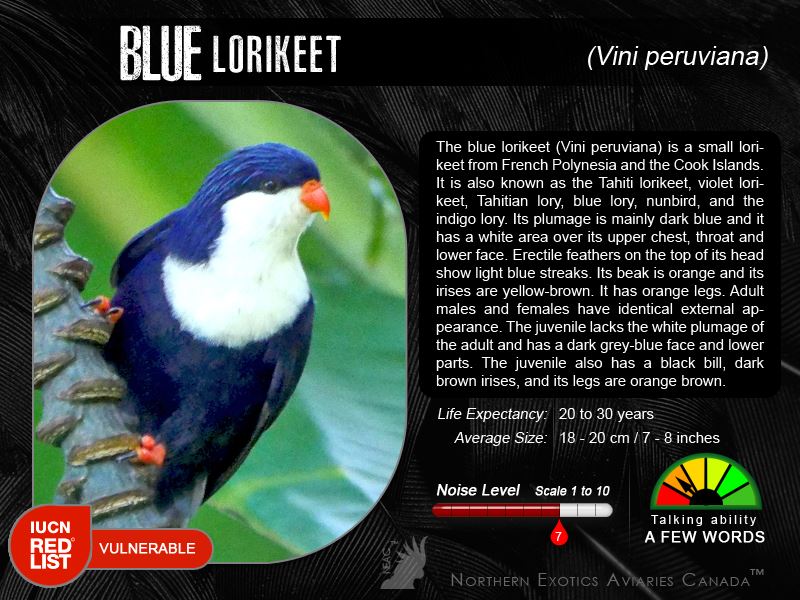Blue Lorikeet - Vini Peruviana - Vulnerable
The blue lorikeet (Vini peruviana) is a small lorikeet from French Polynesia and the Cook Islands. It is also known as the Tahiti lorikeet, violet lorikeet, Tahitian lory, blue lory, nunbird, and the indigo lory. It was formerly found on 23 islands around Tahiti, but now restricted to perhaps eight islands: Motu, Manuae, Tikehau, Rangiroa, Aratua, Kaukura, Apataki, Aitutaki, and possibly Harvey Island and Manihi. Its plumage is mainly dark blue and it has a white area over its upper chest, throat and face. The first captive breeding in the UK was by the Marquess of Tavistock in the 1930s. He was awarded a silver medal by the Foreign Bird League for this achievement.
They are active birds, feeding on nectar, insects, and ground forage.
Distribution and Habitat: The blue lorikeet was originally endemic to the islands of French Polynesia.
It is also present in the Cook Islands, where it is one of a small number of landbirds on the island of Aitutaki. Dean Amadon, writing in 1942 after the Whitney South Seas Expedition, thought that it might have been introduced to the Cooks. David Steadman, who studied the extinct species of the areas, wrote in 1991 that it might have been but that he could find no evidence of this. Had it been native there it would have coexisted with Kuhl's lorikeet; today no Vini lorikeets are sympatric. He later concluded that it was probably introduced, as extensive excavations of fossils had found remains of Kuhl's lorikeet as well as two other species of extinct Vini lorikeet, but no fossils of the blue lorikeet.
The blue lorikeet will live in any wooded habitat within its range, including cultivated areas. It is most abundant in mixed stands of coconuts and Heliotropium foertherianum.
Description: The blue lorikeet is 18 cm long with a short rounded tail. Its plumage is mainly dark blue and it has a white area over its upper chest, throat and lower face. Erectile feathers on the top of its head show light blue streaks. Its beak is orange and its irises are yellow-brown. It has orange legs. Adult males and females have identical external appearance. The juvenile lacks the white plumage of the adult and has a dark grey-blue face and lower parts. The juvenile also has a black bill, dark brown irises, and its legs are orange brown. Blue plumage, which is shares with the related ultramarine lorikeet, is very unusual in the parrot order.

Psittaciformes, The Parrot Index, a part of Phoenix Feathers © 2016 - 2023
Page last updated: 12/24/23
Phoenix Feathers

